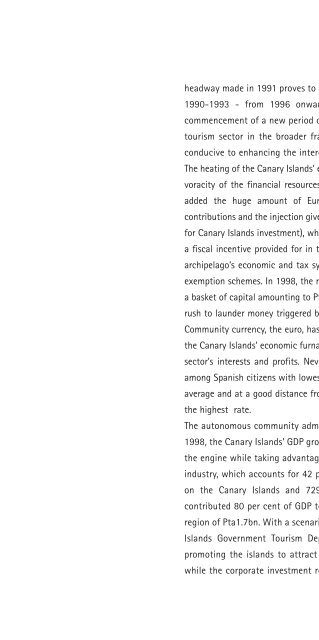Lanzarote: el papel de la crisis - Fundación César Manrique
Lanzarote: el papel de la crisis - Fundación César Manrique
Lanzarote: el papel de la crisis - Fundación César Manrique
Create successful ePaper yourself
Turn your PDF publications into a flip-book with our unique Google optimized e-Paper software.
headway ma<strong>de</strong> in 1991 proves to be clearly ina<strong>de</strong>quate. After some critical years - especially<br />
1990-1993 - from 1996 onwards, there began to appear signs of recovery and the<br />
commencement of a new period of intense economic activity linked to the expansion of the<br />
tourism sector in the broa<strong>de</strong>r framework of a prosperous national and regional situation<br />
conducive to enhancing the interests of <strong>la</strong>rge-scale investors and entrepreneurs.<br />
The heating of the Canary Is<strong>la</strong>nds’ economy came about quickly, favoured by the magnitu<strong>de</strong> and<br />
voracity of the financial resources at stake. To income from the tourism business should be<br />
ad<strong>de</strong>d the huge amount of European funds reaching the is<strong>la</strong>nds, in addition to state<br />
contributions and the injection given by the Reserva para Inversiones <strong>de</strong> Canarias or RIC (reserve<br />
for Canary Is<strong>la</strong>nds investment), which had been accumu<strong>la</strong>ted by the corporate sector thanks to<br />
a fiscal incentive provi<strong>de</strong>d for in the Régimen Económico y Fiscal d<strong>el</strong> Archipié<strong>la</strong>go or REF (the<br />
archip<strong>el</strong>ago’s economic and tax system) for the purpose of boosting investment through tax<br />
exemption schemes. In 1998, the reserve built up a total of Pta226,186m, with p<strong>la</strong>ns to create<br />
a basket of capital amounting to Pta2bn over the next 10 years. At the same time, however, the<br />
rush to <strong>la</strong>un<strong>de</strong>r money triggered by the coming effective introduction in the year 2002 of the<br />
Community currency, the euro, has also p<strong>la</strong>yed an important part in raising the temperature of<br />
the Canary Is<strong>la</strong>nds’ economic furnace, resulting in an unbeatable year in terms of the corporate<br />
sector’s interests and profits. Neverth<strong>el</strong>ess, the inhabitants of the Canary Is<strong>la</strong>nds still figure<br />
among Spanish citizens with lowest income per capita, occupying tw<strong>el</strong>fth p<strong>la</strong>ce, i.e., b<strong>el</strong>ow the<br />
average and at a good distance from the Balearic Is<strong>la</strong>nds, the autonomous community to post<br />
the highest rate.<br />
The autonomous community administration, bedazzled by the myth of ongoing growth - in<br />
1998, the Canary Is<strong>la</strong>nds’ GDP growth rate was 4.58 per cent, ranking third in Spain -, stoked<br />
the engine while taking advantage of the energy r<strong>el</strong>eased to persist in boosting the tourism<br />
industry, which accounts for 42 per cent of Spain’s total supply - 11 million tourists a year<br />
on the Canary Is<strong>la</strong>nds and 729,000 registered accommodation p<strong>la</strong>ces in 1998 - and<br />
contributed 80 per cent of GDP to the archip<strong>el</strong>ago’s economy, with annual turnover in the<br />
region of Pta1.7bn. With a scenario such as this, it is not surprising that, in 1999, the Canary<br />
Is<strong>la</strong>nds Government Tourism Department should have p<strong>la</strong>nned to spend Pta1,500m on<br />
promoting the is<strong>la</strong>nds to attract more visitors. Noneth<strong>el</strong>ess, it does prove surprising that,<br />
while the corporate investment reserve (RIC) and the administration its<strong>el</strong>f h<strong>el</strong>ped raise the<br />
171
















![Becas y premios de la Fundación César Manrique [1997-2006]](https://img.yumpu.com/20766851/1/184x260/becas-y-premios-de-la-fundacion-cesar-manrique-1997-2006.jpg?quality=85)
